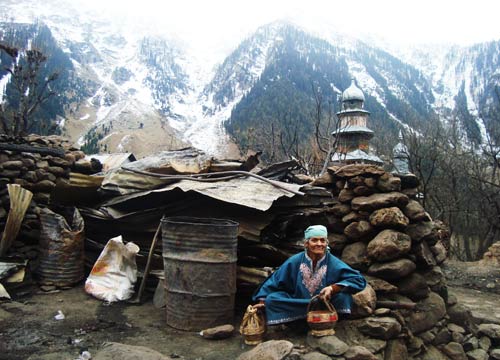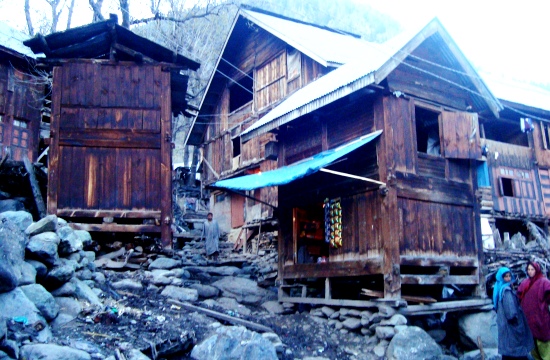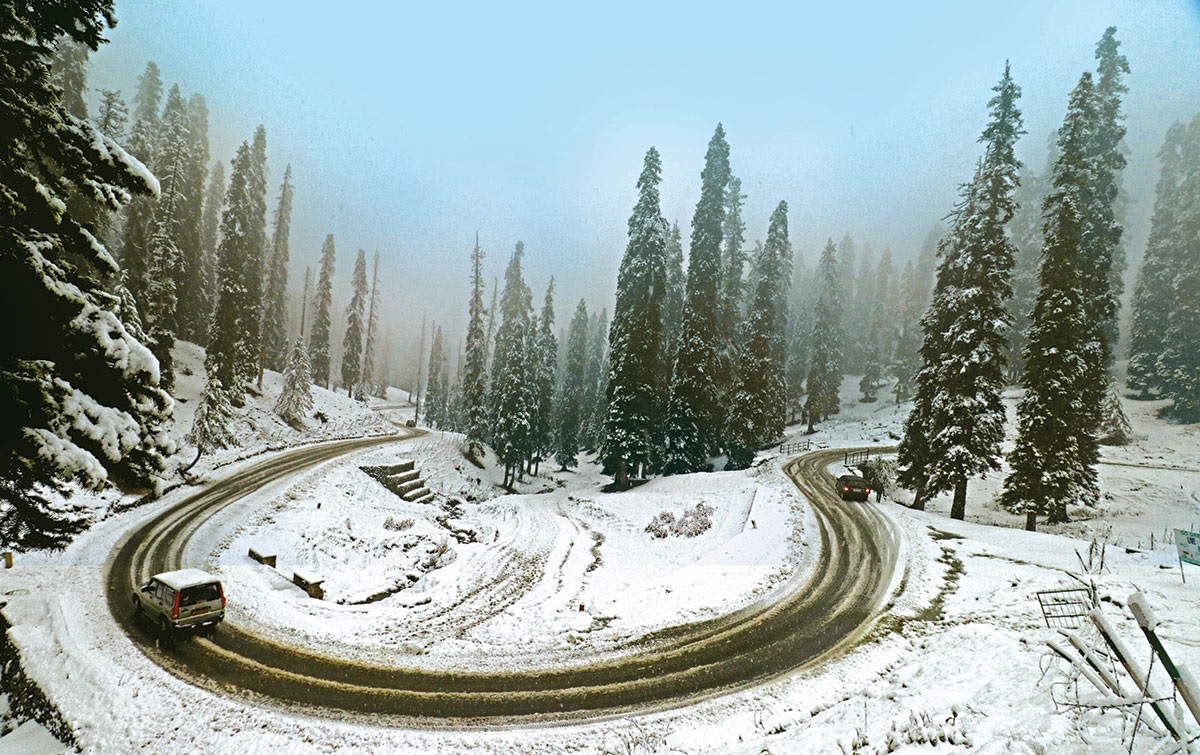A village bearing the imprints of Kashmir’s rich cultural heritage was reduced to ashes in a devastating fire last week which left hundreds of its inhabitants homeless. SHAMS IRFAN visits the village to find out how the victims are coping with the tragedy!

A week after Kashmir woke up to the news of a small village called Frislan near the tourist hotspot, Pahalgam, in south Kashmir gutted to ground in a devastating overnight fire, the smell of burned rubber, animal flesh, stocked food grains and clothing still fills the air.
The tragedy which left almost half of the village without food and shelter in winters has turned into a business opportunity for some people. Every morning, the silence of this sleepy village is disturbed by the whirring of load carrier vehicle struggling to climb steep hills to reach Frislan.
Throughout the day, scrap dealers move hastily from one burned house to other, helping the owners to collect remains of iron, steel or plastic among the rubble. They all wear busy looks. In a corner near the half burned Madrassa building, a thin framed scrap dealer is weighing a charred black tin trunk with his hands, shaking his head in disagreement all the while.
“It’s not worth anything,” he told the owner bluntly while tossing the trunk on the ground. The owner of the tin trunk whose face was covered with dust said something barely audible. “What?” inquired the scrap dealer. Then, clearing his throat, the owner replied, “I had my life’s savings in this tin trunk. At least give me something modest.”
Few steps away, an elderly woman surrounded by half burned walls of her house is sitting on a huge boulder. She is lost in thoughts. Her parched face changes colours as sun moves out from behind the clouds. The paint on the half burned walls around her still smells fresh. It was one of the oldest houses in Frislan, and the most beautifully decorated one too!

It was a d?j? vu moment for me as I remembered my previous visit to the village. I remember walking past this beautiful house whose outer walls were decorated with murals depicting flowers and Presley designs. The image of the old lady sitting proudly in her courtyard, looking in the distance where her grandchildren played hide-and-seek are still fresh with me. She wore a beautiful smile on her face.
Now the house is gone, and so is her smile.
Sitting motionless amidst the rubbles of her house, she seems to have frozen in time as people around her move quickly. She fixes her eye in the distance and watches the chaos unfold around her. On the upper end of the village, a few volunteers from main town of Pahalgam are busy erecting shelters for a makeshift kitchen.
The tragedy has revived the lost connections between different villages in Pahalgam who are otherwise divided by rough terrains, economic stratification and uneven development.
Frislan remains unknown to the outside world except during the annual Amarnath pilgrimage. A narrow road that cuts through the village is black topped every year just before the annual yatra commences. This road is an important link between Chandanwari (yatra base camp) and the main town of Pahalgam from where lakhs of pilgrims travel to Amarnath cave to pay obeisance.
Every year thousands of vehicles pass through this village carrying Indian tourists and pilgrims to Chandanwari, where receding, dirt coloured glaciers fill their photo backgrounds.
But without any tourist infrastructure in place and the recent ban on new construction enforced strictly on the powerless natives, this village attracts no one. Unlike other villages in Pahalgam which saw new avenues opening up with the flow of tourists, Frislan refused to change as it remains stuck in time.

A view of Frislan Village before the fire. Photo: Shams Irfan
As one walks through the ruins, a sense of loss that cannot be replaced by any rebuilding sets in. Small dwellings made of mud and wood with colourful diamond shaped window panes were the last remnants of Kashmiri cultural heritage. There were no boundary walls in Frislan village. To reach the upper end of the village, one just had to pass through the common, unmarked courtyards. There was nothing modern about Frislan. No uninterrupted electricity, no drainage system in place, no water connection and not a single concrete lane. The main source of income for Frislan comes from annual yatra itself. In August, when annual yatra starts, the entire village wears a deserted look as most of the male members camp either at Chandanwari or Sheeshnag to cater to the huge rush of yatris.
A pack of dogs attracted by the smell of dead animals roam around the village scavenging through the burned cattle sheds. The mountains surroundings the village are covered with fresh snow. As I walked towards an under construction building which has been turned into a makeshift disaster management centre, it started to snow. All the relief material brought by individuals and non-government organizations was collected at this centre and then distributed among the affected families by the village heads.
Shabir, whose small two-storey house was gutted completely, considers’ himself lucky to have escaped unhurt. Like everybody else, Shabir too is unclear about the origin of fire. All he remembers was that there was chaos; people were shouting, carrying water, trying to save whatever they could and run for their lives. Nobody knew what to do.
His biggest challenge is to find a shelter. Shabir and his family had spent first two nights in a makeshift tent. “It is unbearably cold out here. I have small kids. They won’t survive in the coming winter if I don’t provide them proper shelter.”
“Thank god nobody was hurt. We can start our lives afresh,” said Ibrahim, an elderly man who tightly held two mattresses in his arms provided by the relief committee.
After the fire, there is lot of activity going around Frislan. All day long, people keep coming to this village carrying blankets, warm clothes, eatables, etc. with them to help the distressed natives. But everybody seems to be in a rush to get out of Frislan to their lives. Nobody wants to stay. Nobody wants to share their pain. Like scrap dealers, they all want to finish their job and leave.
















The loss of Frislan is really ‘the loss of heritage site.bcoz it was perheps only in Frislan where one could see modest ,old wood houses standing on huge logs of wood.the writer has painted the story with a natural brush n paint in his hands.good luck ahead.
Zahoor Lone
pahalgam